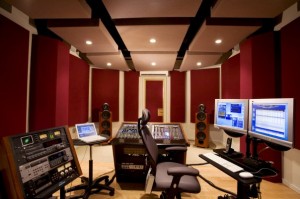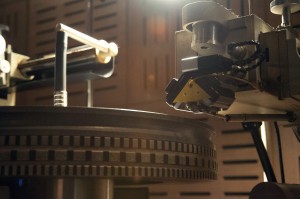Is the Mastering Engineer Still Relevant?
Want to learn everything you need to know to start mastering tracks for yourself or for others? Try Mastering Demystified risk free for 30 days at MasteringDemystified.com.
Years ago, the term “Mastering Engineer” was a very literal one. The “M.E.” was simply the person responsible for creating the master copies of a recording, from which all commercial duplicates could be made.
Today, the title has evolved to mean something a little bit different, and much broader in scope. As changes in technology continue to disrupt the music industry, the value and day-to-day realities of the mastering engineer’s job continue to morph.
The Evolving Role of the Mastering Engineer
Throughout most of the 20th century, creating masters was an incredibly specialized process, and it required equipment that couldn’t be found just anywhere. Recordings mixed onto magnetic tape had to be transferred to disc by painstakingly etching grooves into a sheet of aluminum, covered in a layer of nitrocellulose lacquer.
Later on, a DAT cassette full of mixes might be captured into a specialized hard disk recorder or workstation before a master CD was printed and sent directly to a large pressing plant. This process, of effectively and cleanly transferring recordings to a master format, was tedious, complicated, and easy to mess up.
But these days, creating distro-ready “masters” is as easy as checking the right box when exporting mixes from Pro Tools, Logic, or any other DAW. This only becomes more and more true as digital distributors increasingly accept—and often expect—raw WAV files, or even MP3s, as the final delivery format.
For the dwindling physical market, everyone’s grandma is just a few mouse clicks away from burning error-free CDs using iTunes. Those who still deal with large runs of CDs can use inexpensive programs to create the DDP or “disc description” files that some large scale replicators still rely on.
Of course, whenever technology makes one job easier or more automated, human beings have a way of dreaming up new ones. As the onward march of technology made this original and primary function of the mastering engineer progressively simpler, the most significant value-add that the mastering engineer could offer became an aesthetic one.
For the past couple of decades, audio professionals have been most likely to think of the primary role of the mastering engineer as being the judicious use of EQ, compression, limiting, widening, de-essing, mid-side processing, and other tools of the trade, to make recordings sound even better than when they got them. While anyone could burn a CD, enter in metadata, or upload an audio file, the MEs were the ones who could most effectively sweeten and finalize the sound of a recording. Perhaps even more centrally, they were also the ones who got the final tracks up to what their clients considered an appropriate level of loudness and dynamic range for their style.
Now, even that role is increasingly threatened by novices wielding preset-rich plugins like iZotope’s Ozone, and recently, a new cloud-based automated “mastering” algorithms like LANDR or mastering.studio. There are now frequency analyzers, brickwall limiters and multi-band compressors in every DAW, and seasoned mix engineers are able to deliver mixes that sound louder and more polished than ever before without relying on a mastering engineer to turn a few knobs for them.
So what, if any value remains, in the services of the specialized mastering engineer?
Potentially, quite a bit. What has really changed is that the primary value of the role has shifted from one part of the job to another.
Perhaps most crucially, today’s mastering engineer acts as a final, fine-toothed QC for the most seasoned mix engineers, and as a sweetener, sonic consultant and coach for newer mixers.
It’s a far cry from simply transferring recordings from one format to another, but in ways it can be more fulfilling, and in some cases, more valuable than ever.
The Final Set of Speakers, The Final Set of Ears
In recent years, there has been a staggering increase in the number of neophyte engineers and small recording studios advertising that they “mix and master,” leading many industry veterans to wonder: “wait, is that a thing now?”
There is no doubt that almost anyone who knows how to use a DAW can now fulfill the two major historic functions of the mastering engineer—Both creating the final deliverables and sweetening the sound of finished mixes. But those recording and mixing engineers who advertise that they “master” their own projects are likely cutting themselves and their clients short. That’s because they fail to take advantage of the most significant remaining value of the mastering engineer.

A view of the original Joe Lambert Mastering, where SonicScoop editor Justin Colletti served his clients when he started mastering.
In today’s industry, the primary remaining value of the mastering engineer—the one value really worth paying for—is that he or she offers a final and independent QC of each project. They are a second, and most importantly, a separate set of ears, double-checking the frequency distribution, noise level, loudness, dynamics and consistency of tracks in a listening environment specially suited to that purpose.
That remaining value is a huge one. Almost all mixing and recording rooms suffer from frequency response that is twisted and unreliable in some way, particularly in the bottom end. Anyone who has worked on records long enough has been in the position where they’ve moved their head 3 inches to the right, only to find that the bass response is wickedly skewed one way or the other. When this happens, which position do we trust? How much bass is appropriate?
The mastering engineer knows, in great part because his second, specialized room and monitors allows him to reveal it. She can tell, because years spent listening to hundreds or thousand of recordings in the same kind of critical listening space informs what sounds “normal” and appropriate, and just how far you can effectively push at the very boundaries of taste.
I would argue that today, when people say “mastering”, they mean not just loudening, sweetening, song sequencing, and the entering of metadata. The very least of their concerns is likely the actual creation of the master files themselves. Today, “mastering” is an act of independently QCing a recording, as much or more as it involves informed aesthetic decisions, entering metadata, and creating master files.
Is the third party help of a mastering engineer necessary in the 21st century? Perhaps not, but neither are most of the things we consider valuable and worthwhile—audio recordings and smartphones and studios and dentists and almost all of your most-prized possessions and favorite concert memories among them.
The Automated Engineer
For hobbyists, and some professionals who need to put out copious amounts of audio very rapidly, plugin presets, or an automated algorithmic system like the cloud-based LANDR may have some real value.
“LANDR revolutionizes the mastering process with drag-and-drop simplicity, achieving results that rival professional studio work in minutes,” boasts the LANDR website. Their web-based software is marketed as being driven by “incubated and refined algorithms developed over eight years of university research, testing and tweaking based on feedback from trained audio experts.”
Their website informs that the LANDR system is built around an adaptive engine that ‘listens’ and reacts to music, using micro-genre detection to make subtle frame-by-frame adjustments selectively using tools like multi-band compression, EQ, stereo enhancement, limiting and aural excitation based on the unique properties of the song. [T]the more we throw at LANDR, the better it gets.”
In cases where the choice is between having poor audio or a decently sweetened sound mix, such as may be the case for podcasters or YouTube channels, systems like these might service some users’ needs well, just as they did in the age of broadcast.
For commercial recordings however, the prospects are likely to be more limited. The whole point ultimately, is human expression—not computer expression. While algorithmic presets can potentially excel at doing things the “right way”, a significant liability of such systems is that even at their best, they would fail to ever tastefully do the “wrong” thing.
And that remains a fundamental value of human discernment: We, as a species, have a knack for re-imagining and re-contextualizing what “good” means, especially when it comes to art and creative work. That is one thing our computers simply can’t do for us.
Recently, there has been a tremendous amount of disruption in the audio world. But even as new technology conspires to sweep an ever increasing number of jobs and chores into the dustbin of history, there is always some new and valuable work waiting to be done by human beings.
Justin Colletti is a mastering engineer who writes and talks about music, sound, and how we make it.
Please note: When you buy products through links on this page, we may earn an affiliate commission.








Shane McGill
October 10, 2014 at 1:07 am (10 years ago)Well, I still don’t know why one would need ‘mastering’ in this days! And I really think ‘mixing’ includes ‘mastering’ – there is no transfer to difficult media involved anymore and regarding the super duper monitors mastering masters supposedly use – what does that help if the majority of the listening audience jives on iPhones with or without ear buds and maybe lap-tops! Whatever your music is mixed on it will sound very very different on the other side of the fence.
PS. besides that I do vote for banning words like ‘disruption’, ‘democratization’, and of course the good old stand-by ‘game changer’ 😉
Reghu
October 16, 2014 at 4:57 pm (10 years ago)Depends on your workflow…some EDM producers master themselves. I do my best work in cahoots with mastering engineers. Extra 200 bucks for a trained pair of ears and a audio confidant…heck yea.
gullfo
October 17, 2014 at 9:23 am (10 years ago)definitely a proper mastering engineer is needed if you’re serious about the quality of your material – especially if you’re cutting to CD, vinyl, etc. not only do they have the critical listening space and equipment, but also the critical listening ears and experience to bring out the best in your work. sequencing of songs on an album, balance, dynamics, etc. an experienced ME will also know to listen on not only their high end systems, but also low-res gear like ear buds, small speakers etc as a final check – time consuming and necessary. you get what you pay for….
Nick Dofflemyer
October 24, 2014 at 5:17 pm (10 years ago)I found your article excellent. Those engineers that try to do it all, are TOO Emotionally involved with the project at hand and make difficult to make Non-Emotional choices to establish the final sound quality of a given project. I make this statement, not because I manage a major mastering studio, because I would always suggest to a client, even if they choose not to use our studio, but to have your mixes mastered by an experienced professional mastering engineer.
The digital age has opened the flood gates for home recordings and that can be a good thing provided that a project is presented properly for mass distribution via iTunes or other digital outlets.
kritikosman
October 25, 2014 at 7:01 pm (10 years ago)Morphing indeed.
Clay M
April 30, 2016 at 12:32 pm (8 years ago)So you don’t want your music to sound as professional as possible because most people don’t listen at a professional level? Thats a pretty ignorant way to think of it. Strive for the best wtf?!!
pianoman
August 18, 2016 at 12:49 am (8 years ago)You don’t need a mastering engineer to make your music sound “professional” anymore – you just need to take the time, and put in the effort, to learn how to use the tools that are now available to anyone with a decent computer and a good set of monitors.